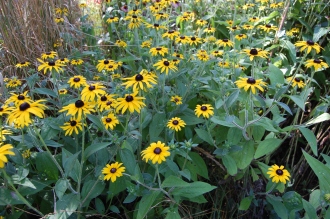Position: Full sun to partial shade
Flowering period: Late summer to early autumn
Soil: Moist, well drained
Eventual Height: 80cm
Eventual Spread: 60cm
Hardiness: 3a, 3b, 4a, 4b, 5a, 5b, 6a, 6b, 7a, 7b, 8a, 8b, 9a, 9b
Family: Asteraceae
Rudbeckia fulgida var. speciosa is a deciduous, herbaceous perennial with a clump forming habit. Its dark leaves are lanceolate to ovate with entire margins, hairy, up to 13cm long and 6cm broad. Its orange/ yellow flowers are daisy like and up to 7cm across. Its roots are rhizomes which aids its spread.
Rudbeckia fulgida var. speciosa, commonly known as Black Eyed Susan, is native to east North America. Rudbeckia fulgida var. speciosa is synonymous with Rudbeckia speciosa. In its native habitat the species inhabits the grassland prairies.
The etymological root of the binomial name Rudbeckia was named for Olof Rudbeck and his son, who was also named Olof, who were 17th century Swedish botanists. Fulgida is from the Latin meaning ‘shiny’. Speciosa is from the Latin meaning ‘spectacular’.
The landscape architect may find Rudbeckia fulgida var. speciosa useful in prairie type planting schemes. Once established this plant is drought tolerant. It is unattractive to rabbits and deer.
Ecologically, Rudbeckia fulgida var. speciosa is attractive to pollinating insects. Some birds are attracted to its seed heads.
The Royal Horticultural Society has given Rudbeckia fulgida var. speciosa their prestigious Award of Garden Merit in 2002.
Rudbeckia fulgida var. speciosa prefers moist, fertile, well-drained soils. It tolerates most pH of soil.
Rudbeckia fulgida var. speciosa requires little maintenance. Large clumps may be divided in autumn or spring.








